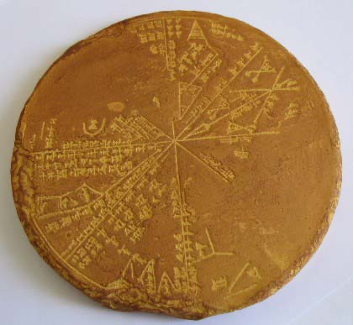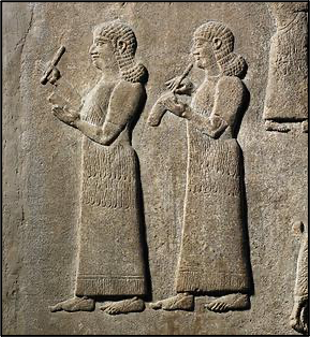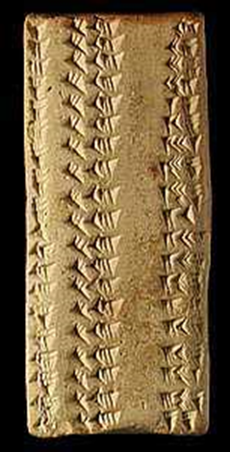Stephanie Guerin-Yodice
As Sumerians developed city-states and defined the borders of kingship towns, agriculture and industry increased to the point of specialization. Specialization occurs in an advanced agricultural society when staple crops experience high yields and grain stores can adequately feed the community, thus freeing people up to develop trades in specific areas: either in commodities, services, or luxury goods. Using obsidian glass as an example, we can trace the development of a commodity to a luxury item through travel and trade networks. Obsidian glass from the upper Anatolian region was a hot commodity to regions that did not have volcanic activity. Communities local to this resource had an advantage in the trading industry because many other regions wanted to obtain the valuable glass that was cut from the hardened volcanic lava. A trader would most likely gather up a local commodity, such as stored grain from Lagash, and travel north beyond Kanya, to Çatalhöyük, in the hopes of trading one commodity for another. Along the way, a bartering system allowed the trader to distribute grain or other valuable commodities in exchange for food and lodging until reaching the foothills of Hasan Dağ.[1] From there, grain could be traded for the obsidian glass, which became available through either mining or local trade networks. Once the trader returned home, the glass was distributed through either a marketplace or personal transactions. Depending on the need or intended use for the glass, an artist could use it in jewelry, a builder could use it to carve intricate details, or a physician could use it to perform surgeries. The journey to obtain the obsidian could take up to three months, so before the trader left, a promissory note was made by imprinting the symbol of grain plus the amount taken with another register, identifying the amount of obsidian glass the trader would exchange for the grain.
The Life of a Scribe: The term dubsar refers to an ancient Mesopotamian scribe, but in modern terminology the people who wrote, recorded, and transcribed the written word would be called linguists, historiographers, artists, revisionists, instructors, and reporters. In fact, the role of a scribe in the ancient world was highly respected and not easily obtained. Traditionally, ancient societies were structured so that children took up the trade of their parents. Boys continued to farm their fathers’ fields, and girls were expected to raise children or take up the artisan craft of their mothers.
Education was not extended to everyone, and the training needed to become a scribe was long and rigorous. Young boys with social status and financial means could be sent to bit tuppi, or a “tablet house” school. There they were taught the style and structure of impressing wedge-shaped markings into clay by first copying short proverbs and simple textual passages. Next, students began the arduous task of transcribing lists consisting of signs, symbols, vocabulary, grammar, and sounds, followed by extensive training in linguistic translation, the number system, lexical text, and the role of a scribe within the community. Once schooling was complete, scribes were employed for a multitude of reasons: by the government, business owners, the royal court of a king, or even their friends and neighbors, but the highest role for a scribe was to become a priest, which during ancient times meant a person highly valued in society and not just held authority in religious matters but also held political importance . The scribes and scholars of ancient Mesopotamia played a seminal role in transmitting knowledge and disseminating ideas.
Astrology: All this record-keeping and administration required much more than the ability to calculate and record day-to-day transactions. State-building demanded an efficient system for measuring long periods of time. Similarly, agriculture required more than irrigation techniques, so the Sumerians invented calendars. Through careful observation of celestial patterns, they divided a year into 12 months according to the cycles of the moon. This interest in measuring long periods of time led the Sumerians to develop a complicated knowledge of astronomy. The zodiac was another invention used to measure yearly time. However, adjustments needed to be made since a lunar month is 29 days and 12+ hours, which does not exactly correlate with a solar year, which is 365 and a quarter days (actually 365 days, 5 hours, 48 minutes, and 47.8 seconds). To deal with this mathematical inaccuracy, around 2500 BCE an intercalary day was inserted every four years, creating a “leap year” that brought the seasons back to normal.[3]
In a modern society people can use their electronic devices to access weather forecasts, but the people of ancient Mesopotamia looked to the sky to understand their physical environment. Mathematic innovations helped them to chart and map the daily movement of the planets and stars, which allowed them to track the passage of time with a 12-month calendar and a pattern of changing seasons, all of which is still used today. Astrological observation could also predict the best seasons for sowing and reaping crops. The constellations also became important to those early societies, as they were central to folklore and mythmaking. Where modern scientists and astronomers have advanced technology to evaluate the depth of our sky above, people of the ancient world relied on epistemological and metaphysical knowledge.[4]
Through knowledge passed down for generations, the pattern of the solar system was observed, calculated, and recorded because ancient civilizations believed that everything happened for a reason. If people could understand the movement of the sky, they thought that they could interpret their future. In modern times we understand that thunder is created by atmospheric conditions but imagine experiencing thunder and lightning while living in 3000 BCE. This was a very scary and unpredictable phenomenon to which no rational understanding could be applied. When they were unable to explain the reason for thunder and lightning, early societies turned to metaphysics. Other everyday events and rare occurrences also took on a deeply religious meaning for the same reason.

For instance, the movement of the stars and planets assumed names, had personalities, and demanded rituals of worship. The people of ancient Mesopotamia believed their gods and goddesses were personified in the planets and that their movements conveyed their wishes. The gods and goddesses became zodiac signs and were associated with the months of the year. What we call the planet Venus was then called Ishtar, after the goddess of love, war, and fertility. Mercury was Nubu, god of wisdom, and Mars was Nergal, the god of pestilence. Nergal imbued feelings of death and destruction and was associated with the sun that scorched the earth of vegetation. Nerghal would conquer Tammuz, the god of food, so a funeral was held for Tammuz when he died each year when the season changed from summer to fall. [5]
[1] Geologists have identified the glass from this volcano was widely traded throughout the Middle Eastern Region. See Cherratt.
[2]. “Cuneiform Mathematics,” A Library of Knowledge of the Cuneiform Digital Library: Science & Technology, May 5, 2017. Accessed February 7, 2018. http://cdli.ox.ac.uk/wiki/doku.php?id=history_of_science
[3]. “Astral Sciences,” A Library of Knowledge of the Cuneiform Digital Library: Science & Technology, May 5, 2017. Accessed February 7, 2018. http://cdli.ox.ac.uk/wiki/doku.php?id=babylonian_astronomy
[4] “Astral Sciences,” A Library of Knowledge of the Cuneiform Digital Library: Science & Technology, May 5, 2017. Accessed February 7, 2018, http://cdli.ox.ac.uk/wiki/doku.php?id=babylonian_astronomy
[5]. Massoume Price, “Astrology and Astronomy in Iran and Ancient Mesopotamia,” Iranian Chamber Society, December 2001. http://www.iranchamber.com/calendar/articles/astrology_astronomy_iran_mesopotamia.php.



